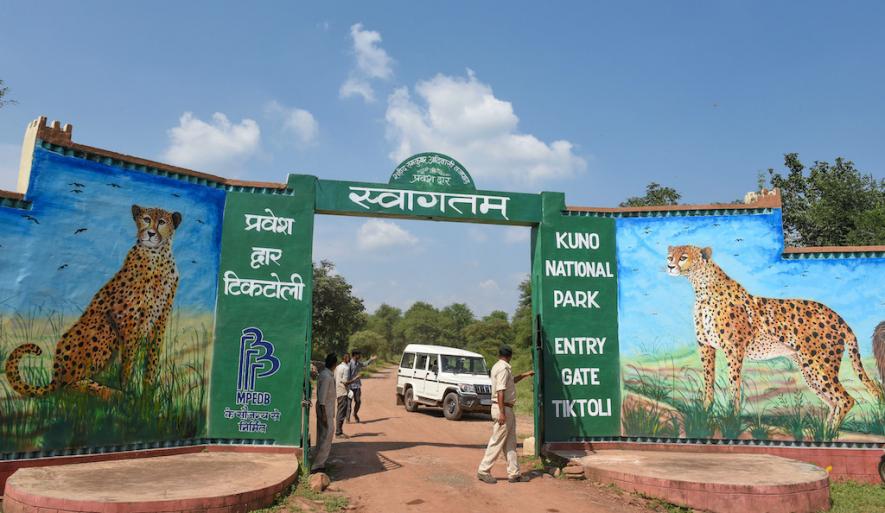Cheetahs From Namibia Will be Very Costly Mistake—Wildlife Biologist Ravi Chellam

Sheopur: Preparations underway at the Kuno-Palpur National Park where Prime Minister Narendra Modi will release cheetahs brought from Namibia.
On 17 September, India will introduce eight cheetahs from Namibia in the Kuno National Park in Madhya Pradesh. For years, this park awaited Asiatic lions from Gir Forest in Gujarat, their last habitat, but Gujarat never parted with them. The consequences were severe for the lions: from 2013 to 2018, 413 Asiatic lions died, many due to adverse conditions. The Centre’s switch to cheetahs for Kuno probably means the lions lose their shot at a new habitat. NewsClick contacted leading wildlife biologist Dr Ravi Chellam, a member of the expert committee of the central government to oversee the translocation of Asiatic lions, to discuss the fresh concerns in light of the introduction of the cheetah. He says India must preserve local endangered species and respect Supreme Court orders that enjoin translocation of Asiatic lions. Excerpts from an email interview by Rashme Sehgal.
You once described the introduction of cheetahs from Namibia to Kuno Palpur in Madhya Pradesh as a “vanity project”. Why? The Ministry of Environment, Forests and Climate Change (MoEFCC) describes it as a significant step to reintroduce a big cat once integral to Indian wildlife.
It does not give me any pleasure to describe this project in the terms I used several months ago. The facts speak for themselves. This project is being rushed through to meet some goals other than conservation. It is not even mentioned in the National Wildlife Action Plan (2017-2031). It will divert attention from far more critical conservation issues. It will stall and further delay the Supreme Court-ordered translocation of lions to Kuno. The scientific foundation leaves a lot to be desired. The conservation goals are unrealistic and even unfeasible. Unfortunately, this will be a very costly mistake.
In 2013, the Forest Bench of the Supreme Court said that instead of “obsessing” over the cheetah, we must protect local endangered species, especially the Asiatic lion. This judgement was partially modified by the more recent 2020 Supreme Court judgement, which said India could import cheetahs on an experimental basis. On what evidence was the second judgement given?
The National Tiger Conservation Authority (NTCA) filed a review petition seeking clarification from the Supreme Court that its 2013 order did not impose a blanket ban on introducing African cheetahs in India. In an interim order delivered on 10 April 2018, the court stated, “It may be mentioned that earlier the intention was to import the African cheetahs into Kuno, Shivpuri (Madhya Pradesh). By way of this application, the reintroduction of the cheetahs from Africa is sought to be made in some other places as mentioned in para 3 of the application.”
It is important to note that the court has clearly mentioned that the NTCA seeks to introduce African cheetahs to sites other than Kuno. I quote from para 3 of NTCA’s application, which the 2018 order mentions, “Pursuant to the above order, efforts have been made to investigate alternate sites for the reintroduction of cheetahs into India, such as Nauradehi Wildlife Sanctuary, Madhya Pradesh, as well as Sathyamangalam Tiger Reserve, Tamil Nadu.” And look at where we have landed!
The Madhya Pradesh Forest Department prepared Kuno Palpur to reintroduce Asiatic lions but suddenly changed the initiative. Why?
The change has been from the government of India, and the state government has basically gone along with it. It is not something the state government initiated.
Scientists say the government should have translocated Asiatic lions from Gir. The 674 lions spread across 30,000 sq. km of forest have only 1,648 sq. km of protected forest. Roaming in unprotected forests, wastelands and agricultural land, these lions often eat livestock carcasses and are susceptible to feral dogs’ attacks. Huddled in one place, they are susceptible to deadly diseases. Why is ‘pride of Gujarat’ not given priority?
This question is difficult for me to answer. What I know is there is a standing order of the Supreme Court dated 15 April 2013, which asked the government of India to translocate lions from Gir to Kuno within six months. This order is of the highest court in our country. If the government continues to ignore it and acts with impunity, it most definitely raises issues related to respect for the rule of law.
Project Cheetah will cost over Rs. 990 crores, other than Rs. 500 crores a year on maintenance. Could we have used the money to preserve local species and habitats? Are our priorities misplaced?
Very widely varying financial estimates have been bandied about. One of the most recent ones I have seen is Rs. 92 crore. There is a lack of clarity about the exact budget for this initiative and how it will be funded. As I mentioned, it will be one of the most expensive conservation projects India has undertaken. The tragedy is that the stated conservation objectives are unrealistic and unachievable. It would be far more efficient and effective if our attention and resources were invested in realistic and practical conservation actions. For example, preventing further changes in land use, fragmentation and degradation of grasslands and open forest ecosystems, translocating lions to Kuno and moving overhead power transmission lines in critical habitats of the Great Indian Bustard underground.
The cheetah requires a grassland to survive, but Kuno Palpur is a woodland. The cheetah’s prey base is the black buck and chinkara, which have almost been wiped out from Kuno Palpur. Besides, is it not a very expensive proposition to maintain the cheetah and its prey in an enclosure?
All things considered, it is indeed a very expensive initiative. It is especially galling that several ongoing and high-priority biodiversity conservation and research initiatives are gravely impacted by the irregular and infrequent release of funds or very limited to nil financial allocation. Cheetahs are found in a wide range of habitats, including hot deserts, cold deserts, mountainous regions, savannah woodlands and dry forests. I do not see an issue with Kuno from this point of view. However, I have concerns regarding prey since the chital will be the most abundant prey species. Another major constraint is we do not have grasslands of the size cheetahs require. We need 10,000 to 20,000 sq. km of good quality habitat in chunks of 2,000 to 3,000 sq. km, which are connected, for the cheetahs to establish and flourish in India. We do not have this extent of habitat. Without suitable high-quality habitats, this project is unlikely to succeed. The government should have prepared the habitats before getting the cheetahs—poor planning.
Why do you think our wildlife-related initiatives suffer from misplaced priorities?
Science-based, logical, consultative, participatory and inclusive decision-making will ensure that our wildlife conservation efforts deliver on-the-ground results that sustain over time. We need far greater transparency and accountability in such matters.
(Rashme Sehgal is an independent journalist.
Get the latest reports & analysis with people's perspective on Protests, movements & deep analytical videos, discussions of the current affairs in your Telegram app. Subscribe to NewsClick's Telegram channel & get Real-Time updates on stories, as they get published on our website.
























